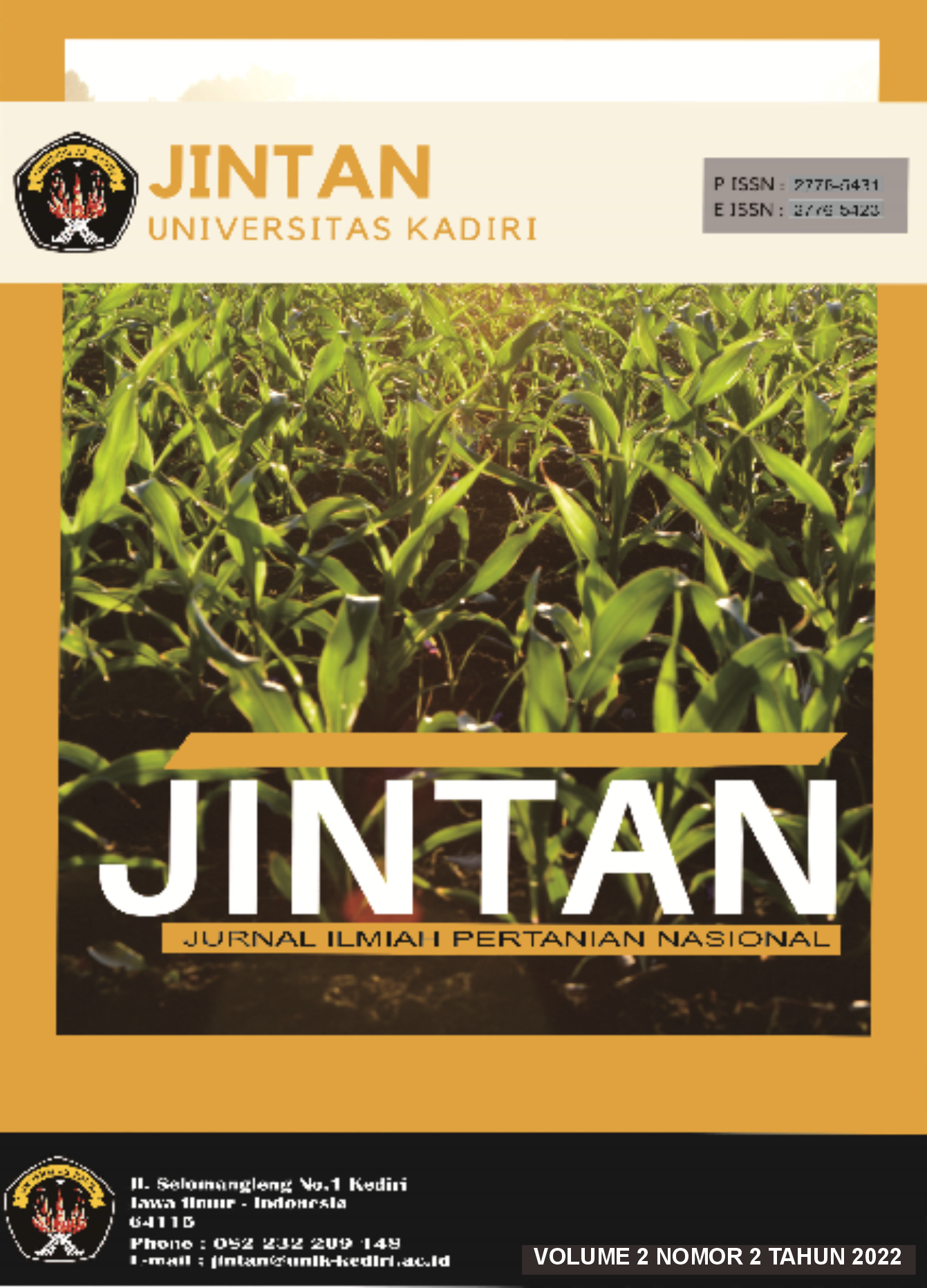Pengaruh Dosis Pupuk Organik Cair Dari Urin Kelinci dan Macam Varietas Terhadap Pertumbuhan dan Hasil Tanaman Bayam Merah (Alternanthera amonea.Voss)
DOI:
https://doi.org/10.30737/jintan.v2i2.2794Keywords:
Dosage, Rabbit Urine, Red Spinach, VarietyAbstract
This study aimed to determine the effect of the dose of liquid organic fertilizer in rabbit urine on the growth and yield of three varieties of red spinach. This research was conducted in Watulimo Village, Watulimo District, Trenggalek Regency at an altitude of 154 meters above sea level from August 23 to October 15, 2021. The study used a two-factor Completely Randomized Design (CRD) which was repeated 3 times, namely: First factor: Dosage of rabbit urine (U) which consisted of 3 treatments, repeated 3 times, namely: U0 = Without fertilizer U1 = dose of rabbit urine 60 ml/plant U2 = dose of rabbit urine 120 ml/plant, Second factor: Red spinach variety (V) which consisted of 3 treatments repeated 3 times, namely: V1 = Mira variety, V2 = Clara variety, V3 = Variety BA-285. From the results of the research that has been carried out, it can be concluded that there was a very significant interaction between doses of rabbit urine and red spinach varieties on plant height at age 14; 21; 28; and 35 days after planting, wet weight per plant and dry weight per plant at harvest time for the best results from the combination of U2V3 treatments. The treatment dose of rabbit urine was significantly different to plant height at 7 DAP, the number of leaves at observation age at 7 DAP, 14 DAP, 21 DAP, 28 DAP, 35 DAP the largest yield was U2, (rabbit urine dose 120 ml/plant). The treatment of varieties of red spinach was significantly different to plant height at 7 DAP, the number of leaves at the observation age at 7 DAP, 14 DAP, 21 DAP, 28 DAP, 35 DAP, and the largest yield was V2, (red spinach variety BA285).
References
Abuyamin. 2016. Pengaruh Pemberian Urin Kelinci dan Kompos terhadap Pertumbuhan dan Hasil Tanaman Caisim (Brassica juncea, L.). ISSN:2089 –8010. Plumula Volume 5 No.1Januari 2016
Advinda, L. 2018. Dasar-dasar Fisiologi Tumbuhan. Deepublish. Yogyakarta. P : 108
Arifah, Dwi, dan N Rochman. 2016. Pertumbuhan, produksi dan kualitas bayam (Amaranthus tricolor L.) pada berbagai dosis pupuk kandang Ayam dan Kalium Niitrat. Universitas Djuanda Bogor.
Lingga, L. 2010. Cerdas Memilih sayuran. PT. Agro Media Pustaka, Jakarta.
Nugroho D., S. 2011. Kajian pupuk organik enceng gondok terhadap pertumbuhan dan hasil bayam putih dan bayam Merah (Amaranthus tricolor L.). [SKRIPSI]. Universitas Sebelas Maret. Surakarta.
Rangkuti, N.P.J., Mukarlina dan Rahmawati. 2017. Pertumbuhan Bayam Merah (Amaranthus tricolor L.) yang diberi Pupuk Kompos Kotoran Kambing dengan Dekomposer Trichoderma harzianum. Jurnal Protobiont, Vol.6 (3):18-25
Rasyid, R. 2017. Kualitas Pupuk Cair (Biourine) Kelinci yangdiproduksi menggunakan JenisDekomposer dan Lama Proses Aerasi yang Berbeda. Skripsi Universitas Hasanuddin. Fakultas Peternakan.
Makassar.Rosniawaty, S. ∙ R. Sudirja ∙ H. Afrianto. 2015.Pemanfaatan Urin Kelinci dan Urin Sapi sebagai Alternatif Pupuk Organik Cairpada Pembibitan Kakao (Theobroma cacaoL.). Jurnal Kultivasi Vol. 14 (1) Maret 2015
Saparinto, C. 2013. Grow your own vegetables-panduan praktis menanam 14 Sayuran Konsumsi Populer di Pekarangan. Yogyakarta: Penebar Swadaya. 180 hlm
Sembiring,M.Y.,L.Setyobudi dan Y. Sugito. 2017.Pengaruh Dosis Pupuk Urin Kelinci terhadap Pertumbuhan dan Hasil beberapa Varietas Tomat. Jurnal ProduksiTanaman, Vol. 5No. 1, Januari 2017: 132 –139.ISSN: 2527-8452.
Sunarjono, H. 2014. Bertanam 36 Jenis Sayuran. Penebar Swadaya.Jakarta. 204 hlm.
Supriati Y. dan Herliana E. 2014. 15 Sayuran Organik datum Pot. Penebar Swadaya. Jakarta. 148
Downloads
Published
Issue
Section
License
Authors who publish in this journal agree to the following terms:
- Authors retain copyright and grant the journal right of first publication with the work simultaneously licensed under a Creative Commons Attribution License (https://creativecommons.org/licenses/by-nc-nd/4.0/) that allows others to share the work with an acknowledgment of the work's authorship and initial publication in this journal. Permitted third party reuse is defined by the Creative Commons Attribution-NonCommercial-NoDerivs (CC BY-NC-ND). This permission allows users to copy and distribute the Article, provided this is not done for commercial purposes and further does not permit distribution of the Article if it is changed or edited in any way, and provided the user gives appropriate credit (with a link to the formal publication through the relevant DOI), provides a link to the license, and that the licensor is not represented as endorsing the use made of the work.
- Authors are able to enter into separate, additional contractual arrangements for the non-exclusive distribution of the journal's published version of the work (e.g., post it to an institutional repository or publish it in a book), with an acknowledgment of its initial publication in this journal.
- Authors are permitted and encouraged to post their work online (e.g., in institutional repositories or on their website) prior to and during the submission process, as it can lead to productive exchanges, as well as earlier and greater citation of published work.
- For open-access publishing, authors have the right to share their articles in the same ways permitted to third parties under the relevant user license, as well as certain scholarly usage rights.
Deprecated: json_decode(): Passing null to parameter #1 ($json) of type string is deprecated in /home/ojs.unik-kediri.ac.id/public_html/plugins/generic/citations/CitationsPlugin.php on line 68




